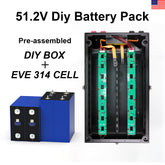BCI Battery Group Size Guide for Group 24 27 31 and More
When it comes to selecting the right battery for your vehicle, RV, boat, or other equipment, one of the most crucial factors to consider is the battery group size. The BCI (Battery Council International) Battery Group Size system plays a significant role in ensuring you pick the correct battery for your needs. In this comprehensive guide, we’ll delve into the details of BCI Battery Group sizes, including Group 24, 27, 31, and other common types, to help you make an informed decision.
- Understanding the BCI Battery Group Size System
- BCI Battery Group 24 Size Overview
- BCI Battery Group 27 Size Overview
- BCI Battery Group 31 Size Overview
- Key Considerations When Choosing the Right BCI Battery Group
- Common Applications for BCI Battery Group Sizes
- How to Properly Maintain Your BCI Battery Group
Understanding the BCI Battery Group Size System
The BCI Battery Group Size system is a standardized classification used to categorize automotive, marine, and RV batteries based on their physical dimensions and performance characteristics. Each BCI battery group is assigned a number, such as 24, 27, or 31, which corresponds to a specific battery size and capacity. These numbers help consumers easily identify which battery will fit their vehicle or equipment and deliver the right performance.
The BCI Battery Group size you need depends on various factors, including your vehicle's electrical requirements, available space for the battery, and how much power you need. Below, we’ll discuss the most common BCI battery group sizes and their applications.
BCI Battery Group 24 Size Overview
BCI Battery Group 24 is one of the most widely used battery sizes, commonly found in standard vehicles, RVs, and boats. A Group 24 battery typically has dimensions of 10.25 inches in length, 6.81 inches in width, and 8.88 inches in height, with a capacity ranging between 70 to 85 amp-hours (Ah). This size is known for its reliability and relatively compact design, making it a versatile choice for many applications.
Group 24 batteries are often used in cars, trucks, and other vehicles that require moderate power. They are also popular in RVs and boats, where a smaller battery size is required without sacrificing performance. When choosing a Group 24 battery, it’s essential to consider the battery's cold cranking amps (CCA) and reserve capacity (RC) to ensure it meets your vehicle's needs.
BCI Battery Group 27 Size Overview
BCI Battery Group 27 is slightly larger than Group 24, offering a higher capacity and more power output. The dimensions of a Group 27 battery are typically 12.06 inches in length, 6.81 inches in width, and 8.88 inches in height. Group 27 batteries generally have a capacity between 85 and 105 amp-hours, making them ideal for applications that require more power and a longer battery life.
Group 27 batteries are frequently used in larger vehicles, including RVs, motorhomes, and boats, as well as in some heavy-duty vehicles. These batteries are known for their deep cycle capabilities, which allow them to provide consistent power over extended periods. If your vehicle or equipment requires higher power output or you need a longer-lasting charge, Group 27 is an excellent choice.
BCI Battery Group 31 Size Overview
For those with high-power requirements, BCI Battery Group 31 is the ideal option. This size is often used in commercial trucks, large RVs, boats, and off-grid solar applications. Group 31 batteries are typically 13 inches long, 6.8 inches wide, and 9.4 inches high, and they can provide a capacity of 100 to 130 amp-hours. These batteries are capable of delivering the power needed for larger equipment or for powering appliances and electronics over extended periods.
Group 31 batteries are well-suited for deep-cycle applications and are built to handle high discharge rates. They are also commonly used in industrial settings and for backup power systems, such as those found in telecommunications or off-grid solar setups. If you require a battery that can withstand heavy loads and provide long-lasting power, Group 31 is a solid choice.
>>See also Is a 4.0 Ah Battery Stronger Than a 2.0 Ah Battery?
Key Considerations When Choosing the Right BCI Battery Group
When selecting the right BCI Battery Group size, it’s essential to keep several factors in mind:
1. Physical Size and Fit
One of the most important considerations when choosing a battery is the available space in your vehicle or equipment. Each BCI Battery Group size has different dimensions, and you must ensure that the battery you choose will fit in the designated compartment. Group 24, 27, and 31 batteries all have different sizes, so check your equipment’s specifications to confirm which size will work best.
2. Power Requirements
Different vehicles and applications require different amounts of power. Consider your power needs in terms of amp-hours (Ah), cold cranking amps (CCA), and reserve capacity (RC). For instance, vehicles that need quick bursts of power for starting, such as cars and trucks, often require a battery with a high CCA. In contrast, deep-cycle applications like RVs and boats benefit from batteries with higher amp-hour ratings for prolonged power supply.
3. Climate and Weather Conditions
Extreme weather conditions can impact battery performance. If you live in a colder climate, you may need a battery with a higher CCA to ensure reliable starts in freezing temperatures. For warmer climates, consider a battery that can withstand higher temperatures and provide consistent power over time.
4. Battery Type and Technology
BCI Battery Group sizes come in various types, including flooded, AGM (Absorbent Glass Mat), and gel batteries. Each type has its own benefits and limitations. Flooded batteries are more affordable but require regular maintenance, while AGM and gel batteries are more expensive but offer better performance, higher efficiency, and lower maintenance requirements.
5. Application Specific Requirements
Different applications may have specific battery requirements. For instance, RVs and boats often require deep-cycle batteries, while automotive vehicles may need a starting battery or a dual-purpose battery for both starting and deep cycling. Understanding the nature of your equipment’s power needs will guide you in selecting the right BCI Battery Group size and type.
Common Applications for BCI Battery Group Sizes
The BCI Battery Group sizes 24, 27, and 31 are used in various applications, from passenger vehicles to off-grid solar systems. Here are some of the most common uses for each of these sizes:
- Group 24: Ideal for compact cars, small trucks, motorcycles, ATVs, and as starting batteries for smaller RVs and boats.
- Group 27: Suitable for larger vehicles such as RVs, larger boats, motorhomes, and some commercial vehicles.
- Group 31: Commonly used for heavy-duty applications, including large trucks, industrial machinery, off-grid solar systems, and as deep-cycle batteries for larger RVs and boats.
>>See also Is Replacing Rechargeable Batteries in Solar Lights a Good Idea?
How to Properly Maintain Your BCI Battery Group
Once you’ve selected the right BCI Battery Group for your vehicle or equipment, proper maintenance is crucial to ensure a long lifespan and optimal performance. Here are some tips for maintaining your battery:
Keep Terminals Clean: Battery terminals can accumulate corrosion over time, which can affect performance. Clean the terminals regularly with a mixture of baking soda and water to prevent corrosion.
Check the Charge Regularly: Monitor the battery’s charge level and ensure it stays within the optimal range. Overcharging or discharging can damage the battery and reduce its lifespan.
Inspect for Damage: Regularly inspect your battery for signs of physical damage, such as cracks or leaks. If you notice any issues, replace the battery immediately to avoid further damage.
Store Batteries Properly: If you plan on storing your battery for an extended period, ensure it’s stored in a cool, dry location and that it’s fully charged. This will prevent the battery from losing its charge and help maintain its performance.
Understanding the BCI Battery Group size system is essential for selecting the right battery for your vehicle, RV, boat, or other equipment. Whether you need a Group 24, 27, or 31 battery, or another size altogether, knowing the dimensions, capacity, and power requirements will help you make the best choice. Always ensure you consider factors such as physical size, power needs, and environmental conditions when selecting your battery.
By following this BCI Battery Group Size Guide, you can confidently choose the battery that will keep your vehicle or equipment running smoothly and efficiently. Remember, choosing the right battery can make all the difference in your vehicle's performance and longevity.
























Leave a comment
All blog comments are checked prior to publishing